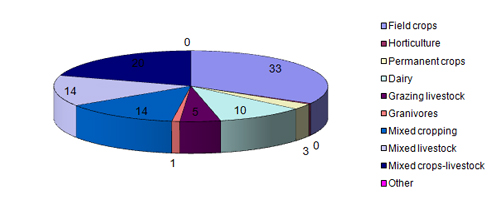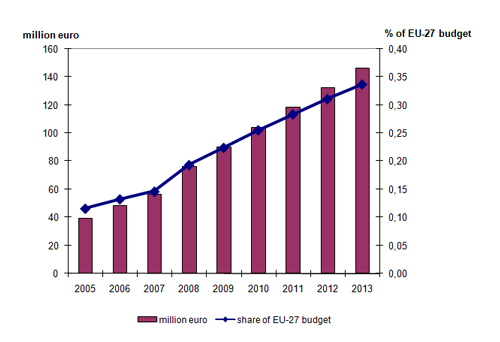Latvia
• General country description
• A. First pillar: implementation of CAP reforms (2003)
• B. Second pillar: implementation of RDP measures during 2007-2013
• C. Vision for the CAP beyond 2013: a short overview of the debate (at Member State level) on future CAP reform
• D. Literature, sources, references
• The comparative analysis provides a compact overview of CAP implementation across all 27 Member States and their visions of the future of the CAP
General country discription
Latvia |
Comparison with EU-25 |
Population, 2005 (*1,000,000): 2.3 |
0.5% of population in EU-25 |
Population density, 2003 (inh./km2): 36 |
118 in EU-25 |
GDP/capita, 2005 (PPS): 10,900 |
47% of GDP/capita in EU-25 |
Share agriculture in total employment, 2002 (%): 15 |
5% in EU-25 |
Share Utilized Agricultural Area in total land area, 2003 (%): 25 |
46% in EU-25 in 1998 |
Average farm size, 2005 (ha): 22.9 |
19 in EU-15 |
Number of farms, 2005 (*1000): 133 (source: 2005 survey on the structure of agricultural holdings in Latvia) |
0.7% of farms in EU-25 |
Source: own calculations based on Eurostat, source Central Statistical Bureau (CSB) www.csb.gov.lv
Distribution of farming types, 2005 (% of total)

Source: own calculations based on Eurostat
EU funding for the Single Payment Scheme (SPS)
and the second pillar, 2007-2013

Funding according to CAP budget including Bulgaria and Romania.
Sources: Agra Europe (2007); CEU (2006); EC (2007a)
A. First pillar: implementation CAP reform (2003)
A.1 Single Payment Scheme
SAPS, as regarding Article 143b(9) of Council Regulation 1782/2003 (amended by R2012/2006) set that for any new Member State the single area payments scheme (SAPS) shall be available for period of application until the end of 2010.
Model
SAPS, Article 71e of Council Regulation 1782/2003 set the new Member States shall apply the single payments scheme at regional level.
Coupling measures
Seperate sugar payments
Reason for selection
No information
A.2 EU budget for Single Payment Scheme (SPS) per year (National ceiling) 2005-2013

Source: 2005: EC (2006); 2006-2013: CEU (2006) and Agra Europe (2007)
Tradability of SPS
No information
A.3 Cross-compliance: Good Agricultural and Environmental Conditions (GAEC)
Source: IEEP, 2005
Selected standards of the GAEC
Issue |
Standards |
Summary of farmers’obligations |
Soil erosion |
minimum land management reflecting site-specific conditions |
no obligations specifically addressing soil erosion |
soil organic matter |
arable stubble management |
incorporate crop residues and stubble into the soil |
soil structure |
appropriate machinery use |
for sowing, maintaining fertilization, restricting weeds and other plant protection activities |
EXTRA: irrigation standards / water management |
land amelioration systems are maintained, ensuring regulation of soil moisture regime except on grassland for biodiversity purposes |
|
protection of permanent pastures |
|
no decrease or adaptation according to the level of decrease (5 or 10%) |
minimum level of maintenance |
minimum livestock stocking rates or/and appropriate regimes |
grassland and meadows are grazed or meadows are mowed or cut at least once before 1 August.. |
avoiding the encroachment of unwanted vegetation on agricultural land |
free from invasive plant species and bushes |
Source: Cross-Compliance in Central and Eastern European Countries/ Republic of Latvia Cabinet Regulation "Procedures by which State Aid and European Union Support shall be Granted for Agriculture and Rural Development"
Latvia pays mainly attention to the minimum level of maintenance to avoid land abandonment. Except for nature grasslands, all lands have to cultivated.
Reason for selection of cross compliance standards
No information
A.4 Further reform of market regulations
No information
B. Second pillar: implementation of RDP measures 2007-2013
B.1 Programme level and approval
There is one national RDP. The Rural Development Committee (consisting of representatives of the 27 Member States) has approved the RDP for Latvia on 20 December 2007.
B.2 Distribution of public budget over the axes (%)1)
axis 1: competitiveness |
axis 2: environment and land management |
axis 3: rural economy |
Axis 4: Leader |
50 |
28 |
20 |
2 |
1) Figures excluding Technical Assistance
Source: Own calculations based on Ministry of Agriculture of the Republic of Latvia (2007)
B.3 Integration of Leader in axes 1, 2 and 3
When implementing local development strategies, local action groups initially build on the following Axis 3 measures: support for business creation and development (code 312); encouragement of tourism activities (code 313); basic services for the economy and population (code 321); conservation and upgrading of the rural heritage (code 323). Further on the number of measures to be used by local action groups may be supplemented (Ministry of Agriculture of the Republic of Latvia, 2007).
B.4 Local Action Groups (LAGs)
At least 20 LAGs will be supported in the programming period 2007-2013. It is planned that at least 85% of the territory of Latvia (meeting the LAG formation requirements) will be covered (Ministry of Agriculture of the Republic of Latvia, 2007).
B.5 RDP budget 2007-2013 (million euros)
total public budget |
% co-financing EAFRD1) |
EAFRD budget |
Contribution private sector |
Total costs |
National top-ups |
1361.6 |
76 |
1041.1 |
1165.5 |
2527.1 |
63.7 |
1) % of co-financing may vary per axis
Source: Ministry of Agriculture of the Republic of Latvia (2007)
B.6 Less Favoured Areas
In compliance with provisions of Article 93 of Council Regulation No. 1698/2005, Latvia continues providing support to the territories of less favoured areas (LFA), which have been specified under Article 19 of Regulation (EC) No. 1257/1999. Having regard of the criteria defined in Article 19 of the regulation above, the status of less favoured area has been granted to 74% of the total state territory or 73% of UAA (1.81 million ha). LFA payments differ by region (category) (Ministry of Agriculture of the Republic of Latvia, 2007). In 2005, 73% of the Utilized Agricultural Area (UAA) (1,160,000 ha) was classified as Less Favoured Area (LFA) (CEU, 2005).
B.7 Drivers of RDP strategy
No information
C. Vision on the CAP beyond 2013*
C.1 Stages in the development of the CAP debate
Is there a debate about the CAP beyond 2013?
No, there is hardly any debate about the CAP beyond 2013. The focus is rather on the preparations for the Health Check. In that debate, the Ministry of Agriculture, farmers organizations and Latvian State institute of Agrarian Economics are involved.
C. 2 Key issues in the debate**
Components and role of the CAP
- To enhance market orientation of farmers and to ensure a free competitiveness on the internal market. CMO elements such as quotas, intervention, export refunds and other production limiting indicators, must be phased out if there is no an objective need for them anymore;
- Abolition of the milk quota system in 2015, with a phasing out scheme until 2015;
- Decoupling of direct payments only if it is applied in all Member States alike;
- Direct payments should not be based on old historical references; equal support eligibility conditions should be strived at;
- Capping of single farm payments of large farms is unfair and could cause large holdings to split up in order to avoid aid caps (Agra Europe, 2008);
- Equal support must be ensured to all EU farmers for maintaining land in good agricultural and environmental condition;
- Abolishment of Article 143b(4) of the Council Regulation (EC) No 1782/2003, laying down that agricultural land of new Member States under SAPS is the part of the used agricultural land, which was in good agricultural condition as at 30 June 2003.
Organization of the CAP (1st and 2nd pillar)
- Complete merger of CAP first and second pillar;
- Establishment of a European Rural Area Policy (ERAP), that provides support directly to actual economic activity and development and management of natural resources.
Financing of the CAP (Agra Europe, 2007)
- The financing received as the result of modulation must serve as the instrument that would diminish the differences among rural areas in the Community. Therefore it must be ensured that a higher share of modulation is transferred to the EU rural development budget as compared with the current share of less than 20%.
* Information provided by Lubova Tralmaka, and Wouter Verhey, Counselor Agriculture, Nature and Food Quality Netherlands Embassy in Warsaw.
** Based on information from Latvian Ministry of Agriculture (2007).
D. Literature, sources, references
- Agra Europe (2007), "Threat of SFP cuts rises as NMS accede", Agra Europe Weekly, January 12
- Agra Europe (2008), "NMS urge end to historical SFP payments", Agra Europe Weekly, March 17
- Council of the European Union (CEU) (2005), Proposal for a Council Regulation on support for rural development by the European Agricultural Fund for Rural Development (EAFRD) - redefinition of intermediate less-favoured areas, Brussels, Working Party on Agricultural Structures and Rural Development, working document (7971/05), 15 April
- Council of the European Union (CEU) (2006), Council Regulation 1782/2003 (consolidated version - August 5, 2006), Annex VIII and VIIIa, Brussels
- European Commission (EC) (2006), 35th Financial Report on the European Agricultural Guidance and Guarantee Fund, Guarantee section, 2005 Financial Year, SEC(2006)1152
- European Commission (EC) (2007a), EU support for rural development 2007-2013; Pre-allocated funding under Heading 2 "Natural Resources" of the Financial Framework, Brussels: European Commission
- European Commission (EC) (2007b), Overview of the implementation of direct payments under the CAP in Member States Version November 2007, EC, DG for Agriculture and Rural Development
- IREAS Institute for Structural policy (2004), Cross-Compliance in Central and Eastern European Countries
- Ministry of Agriculture of the Republic of Latvia (2007), Rural Development Programme 2007-2013, version 30 May 2007
- Latvian Ministry of Agriculture (2007), What should be discussed during the "health check" of the CAP? Latvian position; at website http://www.zm.gov.lv/doc_upl/check_FINAL_050607.doc
- Ministry of Agriculture of the Republic of Latvia (2007), Rural Development Programme 2007-2013, version 14 September 2007
